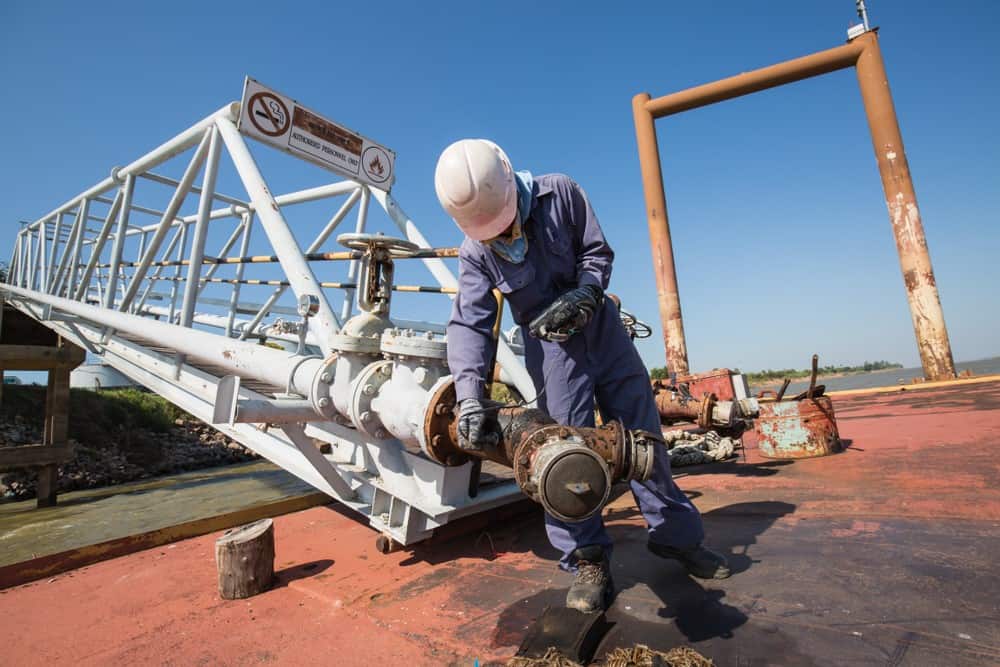Galvanic corrosion, also known as bimetallic corrosion, is a common problem when using steel that has not been galvanized. In galvanic corrosion, two different kinds of metal connected by a common conductive solution decay at different rates, one metal accelerating the oxidation of the other.
Where is Galvanic Corrosion a Problem?
Galvanic corrosion is often seen at welds. The base metal and the weld metal aren’t the same. They have different potentials for releasing and receiving electrons when they come in contact with a solution that generates electrons or that can conduct electricity, like salt water or acid rain.
One metal gives off electrons more easily. It becomes an anode. The other metal gives off electrons less easily. It becomes a cathode.
The anode metal combines with the cation in the conductive solution so it forms rust and other chemical compounds. The microstructure of the metal breaks down. The cathode metal receives electrons from the anode metal and doesn’t break down.
Galvanic corrosion can cause welds to fail. It’s a common problem on oil platforms and in other salt-water installations. But galvanic corrosion isn’t just a problem of marine environments.
Other Situations Where Galvanic Corrosion Occurs: Saltwater Environments
Galvanic corrosion doesn’t just occur when steel parts are placed in saltwater environments. It can also occur when salt water passes through steel pipes.
There are many industrial processes that require removal or recirculation of salt water. There are also situations in which fresh water can become temporarily salty, such as tap water in the summer or during a drought.
Constant exposure to a conductive medium causes galvanic corrosion inside pipes, even if they are galvanized steel. And use of chemicals to kill bacteria and other microbial life to keep water pure is also a source of galvanic corrosion.
But galvanic corrosion doesn’t just occur when metal is exposed to salts. It can also occur in a high-CO2 environment.
Other Situations Where Galvanic Corrosion Occurs: Carbon Dioxide Environments
Carbon dioxide is non-conductive. However, CO2 can combine with water in the air to form carbonic acid. The carbonate from carbonic acid can take electrons from metal to form compounds that make it brittle. Where CO2 comes in contact with two different kinds of metal, one will become an anode, and corrode, while the other will become a cathode, so it is not damaged as much as the other.
CO2 can also break down welds. Remember that metals don’t have to be welded together for galvanic corrosion to be a problem. Anytime two different metals are in contact, there is always a potential for corrosive potential to be “transferred” from one metal to the other.
One metal member will fail, but an adjacent metal member may be in good condition. Inspectors who do not take a close look at all the members in an assembly may miss the problem and fail to recommend corrective action before a structure fails.
What’s the Solution to this Problem?
Galvanic corrosion can be a huge problem when steel is used for pipes. It can be a problem when steel is fabricated for bridge members and plant construction.
The problem is worse at higher temperatures. There is more corrosion when metal is exposed to higher levels of ambient carbon dioxide. But, that doesn’t mean there is nothing you can do:
- You can install a buffer between different kinds of steel.
- You can reduce exposure to electrolytes. Apply a waterproof coating to steel. Use sealants to keep water from seeping into cracks, especially cracks in moving parts. Make sure parts don’t gunk up so corrosive chemicals don’t cling to their surfaces.
- Protect steel parts with zinc galvanizing. A thin coating of zinc provides a sacrificial anode that keeps the metal it covers whole.
Need Help? Contact Us!
Galvanizing isn’t always the answer for preventing galvanic corrosion. It’s just usually the answer for keeping steel structures in service for decades, even in corrosive environments. For all your galvanizing needs, reach out today to see how we can assist you on your project!

